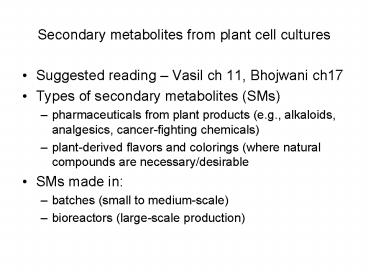Secondary metabolites from plant cell cultures - PowerPoint PPT Presentation
1 / 13
Title:
Secondary metabolites from plant cell cultures
Description:
Secondary metabolites from plant cell cultures. Suggested reading Vasil ch 11, ... sanguinarine is an alkaloid that acts as an agent against dental caries ... – PowerPoint PPT presentation
Number of Views:8444
Avg rating:3.0/5.0
Title: Secondary metabolites from plant cell cultures
1
Secondary metabolites from plant cell cultures
- Suggested reading Vasil ch 11, Bhojwani ch17
- Types of secondary metabolites (SMs)
- pharmaceuticals from plant products (e.g.,
alkaloids, analgesics, cancer-fighting chemicals) - plant-derived flavors and colorings (where
natural compounds are necessary/desirable - SMs made in
- batches (small to medium-scale)
- bioreactors (large-scale production)
2
Secondary metabolites from plant cell cultures
- Features of these compounds
- low molecular wt
- synthesis (in plant cell) is tightly regulated
- A few products are commercially produced
- examples shikonin, ginseng compounds, berberine
- more are not produced because of two main
problems - low yields in in vitro culture
- feedback inhibition from SMs stored
intracellularly
3
Secondary metabolites from plant cell cultures
- Transport mechanisms in cultivated plant cells
- cells that transport SMs to vacuolar space for
storage - final yield limited to storage capacity of medium
- cells that secrete SMs into the medium
- final yield limited to properties of the medium
- production is more easily manipulated, but
separation of culture medium from cultures is
required - SMs originating from cells in the medium,
secreted into the medium, taken up by other cells
and stored
4
Secondary metabolites from plant cell cultures
- Techniques for increasing yields
- usually attempt to redirect transport
- permeabilization
- objective is to permeabilize tonoplast and/or
cell membrane to drive secretion of SM into the
culture medium - chemical agents such as DMSO or Triton X-100
- problem poor viability after treatment
- two-phase systems
5
Secondary metabolites from plant cell cultures
- Techniques for increasing yields
- two-phase systems
- strategy to provide an artificial site for SM
accumulation - example sanguinarine from cultures of
California poppy cells - sanguinarine is an alkaloid that acts as an agent
against dental caries
6
Secondary metabolites from plant cell cultures
- example sanguinarine from California poppy
cells - sanguinarine is an alkaloid that acts as an agent
against dental caries - cells are grown in a 2-liter air-lift bioreactor
- this bioreactor uses 2 phases an aqueous culture
phase and a silicone oil extraction phase - bioreactor is sparged thru a central draft tube
gas bubbles are disengaged thru a top layer of
silicone fluid
7
Secondary metabolites from plant cell cultures
- example sanguinarine from California poppy
cells - difference in specific gravity between aqueous
and extraction phases, as well as gentle mixing
in the airlift system maintains a clean
separation between phases - a small contact area between phases is sufficient
for secretion into the extraction phase - advantages (of this two-phase system)
- silicone extraction phase doesn't affect cell
viability
8
Secondary metabolites from plant cell cultures
- example sanguinarine from California poppy
cells - advantages (of this two-phase system)
- SM product is isolated rapidly
- SM product can be localized in a reduced volume
- elicitation can be incorporated
- biosynthetic enzymes induced (usu. with an
oligosaccharide) - increase in SM production results
9
Secondary metabolites from plant cell cultures
- Other systems
- immobilized cell culture (2 approaches)
- entrapment in alginate beads
- adherence of cells to a porous membrane
- in both cases, the objectives
- control of growth (high nutrient levels first,
then elicitation or starvation) - release of SM into the medium where it can be
harvested
10
Secondary metabolites from plant cell cultures
- Other systems
- hairy root culture culture of fast-growing
roots by - inoculation with Agrobacterium rhizogenes (esp.
useful where differentiated cells are required
for SM production) - transfer of T-DNA causing hairy roots, then
elimination of Agrobacterium by antibiotic - (transformed) hairy roots are first subcultured
to solid, then liquid medium
11
Secondary metabolites from plant cell cultures
- Other systems
- hairy root culture (contin)
- SM is released into the medium, then harvested
- primary advantage a simple system w/o problems
inherent with cell suspensions - limited to spp. susceptible to A. rhizogenes
- biotransformation
12
Secondary metabolites from plant cell cultures
- Other systems
- biotransformation
- chemical conversion of an exogenously supplied
substance by living cell cultures - example addition of hydroquinone (inexpensive
precursor) into liquid culture medium containing
vinca cells results in efficient production of
arbutin (a skin depigmentation agent)
13
Secondary metabolites from plant cell cultures
- Outlook for SM production in plant cell cultures
(where plant cell systems may be preferred over
whole plants) - rare and endangered plants of pharmaceutical
interest - plants that grow too slowly to match a sudden
demand (e.g., Taxol present only in the bark of
Taxus brefolia) - some cell cultures can be made to produce a
single compound, e.g., sanguinarine from poppy
cell culture































